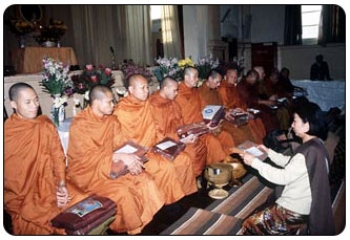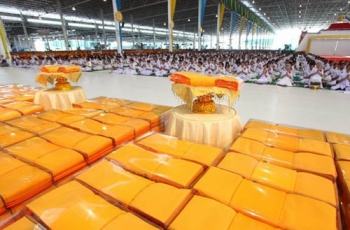Ka?hina and Ka?hina kusala
What is meant by Ka?hina? The Pali term ‘Ka?hina’ means: strong, strength, hard, solid, rigid, powerful, firm, inflexible, and stiff. Therefore, Ka?hina kusala means: ‘very strong wholesome action’and ‘very inflexible, stiff and unbending wholesome energy’. The well-performed Ka?hina kusala is ethically very powerful and certain to give superior and excellent results.
The Ka?hina cloth of Buddhist tradition is the cotton cloth material which is annually supplied by the lay-devotees for the purpose of making robes for bhikkhus who have completed the rains-residence. Earlier, the word was also used to mean, ‘a wooden frame used by bhikkus in sewing their robes’.
Pav?rana Ceremony
At the termination of (vassa) rain-residence, the Pav?rana Ceremony is held by Buddhist monks. The Buddha explains that the performance of certain recitations should be made by monks at the termination of rains residences. Before termination of rains-residence, Buddhist monks fix or determine the date of Pav?rana. Later two kinds of the Pav?rana festival are distinguished, viz;
i. Mah?-pav?rana – The Great Pav?rana and
ii. Pav?rana-sangaha – an abridged Pav?rana.
In the Pav?rana ceremony, monks are so satisfied with coming to the end of rainy season. It is a spiritual satisfaction for them.
Monks from P?va Country
The Buddha was staying at S?vatthi in the Jeta Grove in Anathapindika’s monastery. At that time thirty monks of P?va country, all forest dwellers, all almsmen, all wearers of rag-robes, all wearers of the three robes, came to S?vatthi to visit the Buddha. However, the beginning of the rains was approaching and they were unable to reach S?vatthi where the Buddha was staying, in time for the beginning of the rains-retreat. Then, they had to enter upon the rains-retreat on the way at S?keta. They spent the rains in a state of longing, thinking: “The Buddha is staying very close to us, six yojanas (1) from here, but there is no way for us to have the opportunity to see the Blessed One”.
After three months, having kept the rains-residence, after the invitation had been carried out, the monks journeyed to see the Buddha. However the rains continued showering, waters were gathering and swamps were forming. With wet robes, exhausted and wearied from their journey they arrived at S?vatthi city and proceeded to the Anathapindika’s monastery in the Jeta Grove. Having approached the Buddha, they sat down at a respectful distance. Then the Buddha exchanged friendly greetings with the rain soaked monks saying;
“I hope, monks, the things went well with you. I hope you had enough to support life. I hope that, in unity, being on friendly terms and harmonious, you spent a comfortable rainy season and did not go short of alms food?”
The monks replied; “Things did go well with us, Bhante (Venerable Sir)! We had enough to support the life, Bhante, and in unity we, Bhante, being on friendly terms and harmonious, spent the rainy season and did not go short of alms food.”
“Here are we, Bhante, as many as thirty monks of P?va country, coming to S?vatthi so as to see you Bhante, but when the beginning of the rains was approaching, we were unable to arrive at S?vatthi so for the beginning of the rains we entered on the rains on the way, at S?keta.”
“We spent the rains, Bhante, in a state of longing for you, thinking: “The Blessed One is staying very close to us, six yojanas from here, but we do not have the opportunity to see the Buddha.”
“Then we, Bhante, having after the lapse of three months, kept the rains, and after the invitation had been carried out, while the rain continued, while waters were gathering, while swamps were forming, with wet robes and in a state of fatigue came along on the journey.” (2)
Ka?hina Robe
Then the Buddha, on this occasion, having given a Dhamma-talk, addressed the monks, saying:
“I allow you, monks, to make up Ka?hina cloth when monks have completed the rains.” (Anuj?n?mi bhikkhave, vassam vutth?nam bhikkhunam ka?hinam attharitum) (3)
Since that day, monks make up Ka?hina cloths and used to give to a monk to use as a Ka?hina robe. All the necessary requirements must be fulfilled in accordance with the disciplinary rules enjoined by the Buddha here. The monks who take part in this Ka?hina ceremony have to recite the appropriate P?li stanzas.
---------------------------
End Notes:
1. yojana: a measure of length, a distance of about 7 miles – (See: Pali-English Dictionary, Ed. By T.W.Thys Davids & William Stede, p. 559, P?li Text Society, London, 1999).
2. Ka?hinakkhandaka, Vinaya Pitaka, vol. ii, PTS, London.
3. Ka?hinakkhandaka, Vinaya Pitaka, vol. ii, PTS, London. 















